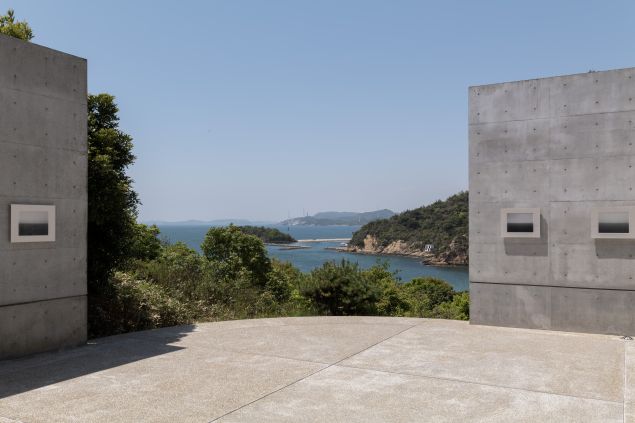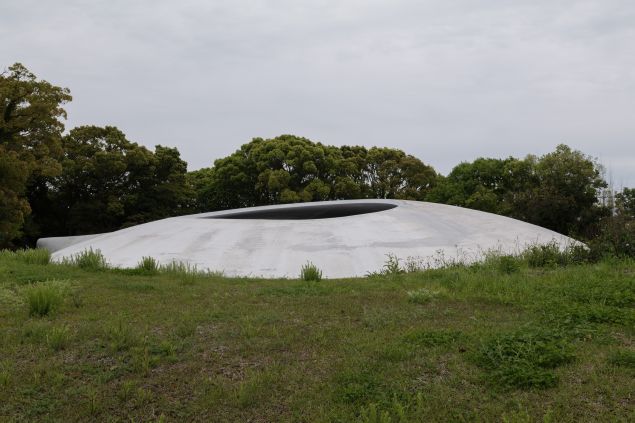
In the heart of the Seto Inland Sea, between the Japanese islands of Honshū, Shikoku and Kyūshū, is Naoshima, a small island community famous for its art and architecture.
Naoshima is only accessible by boat or ferry, and upon arrival, you’ll find art sculptures and installations in the museums as well as every corner of the surrounding tiny villages, sandy beaches and green hillsides, from artists including Claude Monet, James Turrell, Walter De Maria and Yayoi Kusama. Even if contemporary art isn’t the main drive behind your travel adventures, Naoshima, along with the neighboring island of Teshima, offers a transformative experience for those who visit.
Reaching these islands from Tokyo or Osaka can feel like a pilgrimage in itself, and once you’ve arrived, there are a few considerations to keep in mind. While getting to Naoshima is definitely a trek, it’s well worth the journey. Here’s everything you need to know about exploring Japan’s famous art islands.
Subscribe to Observer’s Lifestyle Newsletter

How to get to Naoshima
The least stressful way to reach Naoshima is from Osaka, although the journey still requires several trains and a boat. From the Osaka airport, head to Shin-Osaka station, and then take the Shinkansen high-speed train line to Okayama. From there, you’ll board another train to Uno, a small town on the edge of the Seto Inland Sea. It’s a quick walk to Uno Port, where there are regular car and passenger ferries to Naoshima’s two ports, Miyanoura and Honmura. It’s also possible to travel to Uno from Tokyo, also via the Shinkansen high-speed trains, which pass through Kyoto and Osaka on the way.
Naoshima is also accessible via Takamatsu, a port city on Shikoku Island, located on the southern edge of the coast. Those ferries run from Takamatsu Port, and are also available as passenger or car options. Take note that tickets for all ferries must be purchased with cash, so make sure you’re prepared beforehand.
International travelers should get a Japan Rail Pass, which allows travel on most Japan Rail trains, without having to purchase a specific ticket for each journey. It’s best to reserve seats in advance, especially if you have larger luggage, as these trains tend to get crowded, and even more so during the spring and summer.

Where to stay in Naoshima
There are a few different accommodation options on the island, but Benesse House, a combination museum and hotel, is a standout. Designed by Japanese architect Tadao Ando, Benesse House boasts an extensive collection of artwork, featuring pieces by Claude Monet, Bruce Nauman, James Turrell, Yayoi Kusama and many others. One of the main benefits of staying at Benesse House is access to the museums, including outside of the regular hours of operation, in addition to the free shuttle buses, which are useful for getting around the island. The hotel’s private drivers will also take you to and from the ferry.

The hotel is composed of four distinct buildings; Oval, Museum, Beach and Park. Park and Beach are adjacent to the sea, for those that want a picturesque view, while Museum also houses many of the art pieces, for those that want a truly immersive experience. Each room features original artwork instead of a TV. It’s definitely a splurge; room rates vary by building and type, but for the smallest accommodations during the off season, begin at around $200 per night, though the more deluxe rooms in the high season will cost you over $960 a night.
There are also other hotel alternatives, both in Miyanoura and Honmura. Many of these are small guest houses, but a few newer spots have opened within the past few years, including My Lodge Naoshima and Wright Style. If you want to experience a luxury ryokan (a type of traditional Japanese Inn), try Naoshima Ryokan Roka, which opened in 2022. Check with the hotel beforehand to see if they have any in-house transportation options to navigate around the island; otherwise, you’ll need to take local buses, or rent a bike or car to get around.

What to do in Naoshima
If it’s your first time visiting Naoshima, allot at least two days for your stay. There’s so much to see in Naoshima, with multiple museums and art experiences throughout the island, as well as numerous sculptures and installations. The most famous is surely Kusama’s iconic yellow pumpkin, which sits at the end of a pier—the original was actually damaged during a typhoon, but has since been replaced. Another of Kusama’s iconic pumpkins is situated near the port, alongside the ferry terminal.

The Chichu Art Museum is a highlight; one room is filled with Monet’s famous water lily paintings, in addition to several Turrell pieces. If you visit on Friday or Saturday, book the Night Program, with a viewing of Turrell’s “Open Sky” at sunset. The Lee Ufan Museum, a collaboration between Ufan and Ando, is located nearby, in addition to the brand new Valley Gallery. Down the hill, the Benesse House Museum is known for Nauman’s neon light sculpture.
In Honmura village, the Ando Museum and the Art House Project are worth a visit, as is The Naoshima Plan. Near the port, some intrepid travelers stop by the eclectic Shinro Ohtake-designed bathhouse, titled “I♥︎湯,” where visitors can pay a fee and head inside for a soak.
SEE ALSO: Artist Mariko Mori’s New Crystal Sculpture in Venice Is a Call for Universal Peace
It’s not just about the art, though, as Naoshima’s beaches are a dream for scenic walks, as well as swimming during the warmer months. There are several coffee shops and cafes in Honmura and Miyanoura, although the hours of operation tend to be limited. Hifumiyo Coffee in Honmura is perfect for a latte, and for lunch, try the fish burger at Mai Mai, or the curry at Kon’nichiwa. For a sweet treat, stop at Naoshima Gelato, where the orange milk ice cream is made from oranges grown right in the adjacent yard.
Evening activities can be trickier, as bus schedules are somewhat limited (the hours vary, so check the local timetable beforehand), and many of the restaurants close by 8 pm or 9 pm. Benesse House is home to two fine dining restaurants (one French and one Japanese), but for more casual food options, check out Raumen Tsumu, Luke’s Pizza and Grill or New Olympia. Naoshima isn’t a major nightlife destination, but you might find a bar or two open in Miyanoura.

How to plan a trip to Teshima
While most people base themselves on Naoshima and plan a day trip to Teshima, it is possible to spend a night or two on the more sparsely-populated island. Ferries run three times a day from Miyanoura to Teshima’s Ieura Port (plan according to the limited schedule), or you can go straight to Teshima from Uno or Takamatsu. The passenger ferry takes about 25 minutes from Naoshima (again, pay with cash) and drops you off in small village by the port. From there, you can walk, rent a bike or car, or hop on a public bus to explore the island.
The main draw on Teshima is the Teshima Art Museum, which must be booked in advance. The indoor-outdoor space, designed by artist Rei Naito and architect Ryue Nishizawa, combines architecture and nature, and is a truly special experience. Elsewhere on the island, you’ll find various other works of art and installations, including Christian Boltanski’s “Les Archives du Cœur,” the Teshima Yokoo House, the Needle Factory and Mariko Mori’s “Tom Na H-iu.”
Even though there aren’t a ton of people or buildings on Teshima, the island is somewhat spread out; it’s about an hour-long walk from the port to the Teshima Art Museum, and many of the sites are situated throughout the surrounding coastal areas. It’s a lot to see in one day, so those with space in their itineraries could always book an overnight stay on the island. The recently opened Teshima Espoir Park Inn is a contemporary hotel with sea views and a great dining spot, Umi No Restaurant, right across the street. And before you leave, definitely stop at the shop inside the port building, where you’ll can local ice cream flavors like olive and Setouchi lemon.
